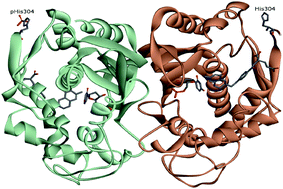Phosphorylation of thymidylate synthase affects slow-binding inhibition by 5-fluoro-dUMP and N4-hydroxy-dCMP
Abstract
Endogenous thymidylate synthases, isolated from tissues or cultured cells of the same specific origin, have been reported to show differing slow-binding inhibition patterns. These were reflected by biphasic or linear dependence of the inactivation rate on time and accompanied by differing inhibition parameters. Considering its importance for chemotherapeutic drug resistance, the possible effect of thymidylate synthase inhibition by post-translational modification was tested, e.g. phosphorylation, by comparing sensitivities to inhibition by two slow-binding inhibitors, 5-fluoro-dUMP and N4-hydroxy-dCMP, of two fractions of purified recombinant mouse enzyme preparations, phosphorylated and non-phosphorylated, separated by metal oxide/hydroxide affinity chromatography on Al(OH)3 beads. The modification, found to concern histidine residues and influence kinetic properties by lowering Vmax, altered both the pattern of dependence of the inactivation rate on time from linear to biphasic, as well as slow-binding inhibition parameters, with each inhibitor studied. Being present on only one subunit of at least a great majority of phosphorylated enzyme molecules, it probably introduced dimer asymmetry, causing the altered time dependence of the inactivation rate pattern (biphasic with the phosphorylated enzyme) and resulting in asymmetric binding of each inhibitor studied. The latter is reflected by the ternary complexes, stable under denaturing conditions, formed by only the non-phosphorylated subunit of the phosphorylated enzyme with each of the two inhibitors and N5,10-methylenetetrahydrofolate. Inhibition of the phosphorylated enzyme by N4-hydroxy-dCMP was found to be strongly dependent on [Mg2+], cations demonstrated previously to also influence the activity of endogenous mouse TS isolated from tumour cells.


 Please wait while we load your content...
Please wait while we load your content...